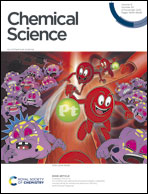Molecular bixbyite-like In12-oxo clusters with tunable functionalization sites for lithography patterning applications†
Abstract
Indium oxides have been widely applied in many technological areas, but their utilization in lithography has not been developed. Herein, we illustrated a family of unprecedented In12-oxo clusters with a general formula [In12(μ4-O)4(μ2-OH)2(OCH2CH2NHCH2CH2O)8(OR)4X4]X2 (where X = Cl or Br; R = CH3, C6H4NO2 or C6H4F), which not only present the largest size record in the family of indium-oxo clusters (InOCs), but also feature the first molecular model of bixbyite-type In2O3. Moreover, through the labile coordination sites of the robust diethanolamine-stabilized In12-oxo core, these InOCs can be accurately functionalized with different halides and alcohol or phenol derivatives, producing tunable solubility. Based on the high solution stability as confirmed by ESI-MS analysis, homogeneous films can be fabricated using these In12-oxo clusters by the spin-coating method, which can be further used for electron beam lithography (EBL) patterning studies. Accordingly, the above structural regulations have significantly influenced their corresponding film quality and patterning performance, with bromide or p-nitrophenol functionalized In12-oxo clusters displaying better performance of sub-50 nm lines. Thus, the here developed bixbyite-type In12-oxo cluster starts the research on indium-based patterning materials and provides a new platform for future lithography radiation mechanism studies.

- This article is part of the themed collection: 2021 Chemical Science HOT Article Collection


 Please wait while we load your content...
Please wait while we load your content...